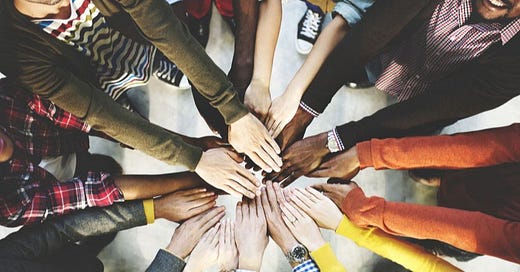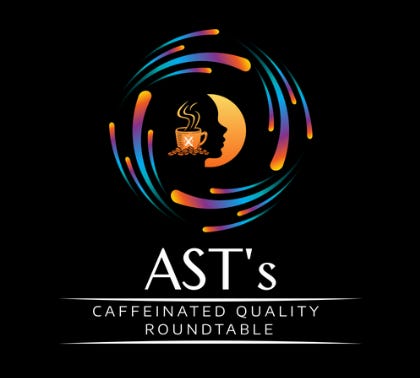AST Monthly News - June 2025
AST NEWS - June 2025: Insights into Diverse Teams
In This Issue:
Featured Article(Author: Prof. Dr. Daniel Russo): Diversity in Software Teams: the gift that can hurt
CAST 2025 Event Updates - FLASH SALE IS ON!!!
AST Member Talent Spotlight: Are you looking to hire? We’ve got some amazing experts ready for their next role!
Caffeinated Quality Updates: Virtual Roundtable Schedule & June Recording
Diversity in Software Teams: the gift that can hurt
Featured article by
Prof. Dr. Daniel Russo originally posted on LinkedIn April 2025
Diversity, equity, and inclusion (DEI) are no longer optional ideals in the world of software engineering — they are essential drivers of innovation, resilience, and meaningful progress.
Across industries, organizations have recognized that diverse teams solve more complex problems, bring richer perspectives, and better reflect the global society they serve. In agile squads, cross-functional feature teams, and engineering organizations alike, building diverse teams is a key strategic priority.
But unlocking the full potential of diversity demands more than assembling individuals with different backgrounds. It requires creating environments where every voice feels heard, every perspective is respected, and every individual can contribute fully.
Our recent research, conducted in collaboration with Christiaan Verwijs and published in the IEEE Transactions on Software Engineering under the title "The Double-Edged Sword of Diversity: How Diversity, Conflict, and Psychological Safety Impact Software Teams," examined data from 1,118 individuals across 161 software teams. It highlights a crucial insight:
Diversity offers unparalleled opportunities — but psychological safety determines whether those opportunities are realized.
When teams cultivate trust, openness, and belonging, diversity becomes a true superpower. Without these conditions, teams risk facing unnecessary misunderstandings and missed opportunities for collaboration.
What the Research Says
Our study investigated how four dimensions of diversity — age, gender, cultural background, and professional role — impact team effectiveness and relational conflict. We also explored how psychological safety acts as a potential moderator: could a safe environment help teams harness the benefits of diversity without succumbing to its pitfalls?
Here are the key findings:
✅ Age diversity is positively related with team effectiveness.
✅ Gender diversity is related with higher relational conflict.
✅ Cultural and role diversity showed no significant direct effects.
✅ Psychological safety significantly boosts team effectiveness and reduces conflict — but surprisingly, it doesn't fully moderate diversity's impact.
In short:
Diversity introduces potential. Psychological safety determines whether that potential becomes power or pain.
Why Diversity Isn’t a Guaranteed Win
Popular discourse often frames diversity as an automatic source of innovation. However, empirical evidence — including our study — suggests a more complex reality.
Two psychological theories help explain this:
Similarity-Attraction Paradigm: Humans naturally gravitate toward those similar to themselves. Greater differences can trigger misunderstanding and friction.
Cognitive Resource Diversity Theory: Diverse teams have broader cognitive resources, enabling richer problem-solving — but only if these resources are successfully integrated.
Without a climate of trust, diverse perspectives may be perceived as threats rather than opportunities. Without open dialogue, differences remain barriers, not bridges.
Thus:
Diversity adds complexity. Complexity demands intentional leadership
Inside the Double-Edged Sword
1. Age Diversity: The Silent Superpower
Age diversity was the most reliably positive force in our findings. Teams with a broad spread of ages reported higher effectiveness.
Why?
Different age groups bring varied experiences and problem-solving approaches.
Older team members often offer contextual wisdom; younger members bring fresh perspectives.
As one senior engineer in a mixed-age team told us:
“The juniors challenge my assumptions. I make sure they don’t reinvent the wheel. It’s a healthy tension.”
In practice, age diversity often translates into cognitive diversity — a wellspring for innovation if managed correctly.
2. Gender Diversity: A Source of Friction
While gender-diverse teams offer richer perspectives, they also reported significantly higher levels of relational conflict.
Importantly, this wasn't about task disagreement (which can be healthy) — it was about emotional friction:
Misinterpretation of communication styles
Different expectations around collaboration and leadership
Subtle exclusion or misunderstanding
The takeaway:
Without psychological safety, gender diversity risks creating emotional fault lines within teams.
This does not suggest that gender diversity is undesirable. It does suggest that organizations must invest intentionally in communication norms and inclusive practices, rather than assuming goodwill alone will bridge the gap.
3. Cultural and Role Diversity: The Complexity Multiplier
Interestingly, neither cultural nor role diversity showed a strong direct impact on effectiveness or conflict in our models.
This challenges simplistic ideas about "surface-level diversity" (e.g., nationality) automatically driving outcomes. It suggests that context, task complexity, and team norms may mediate these effects more than raw demographic differences.
In teams where members collaborated intensely and respected each other’s professional expertise, role diversity was a powerful asset. Where roles were siloed or status-driven, diversity became irrelevant — or even a liability.
Thus:
Diversity is neither good nor bad. It is neutral potential shaped by context.
Psychological Safety: The Great Enabler
If diversity is firewood, psychological safety is the match.
Our research confirmed what many practitioners have long suspected:
Teams with high psychological safety reported far higher effectiveness.
They also reported significantly less relational conflict.
Interestingly, psychological safety did not completely shield teams from the relational challenges posed by diversity. It helped — but it wasn't a panacea.
Thus:
Psychological safety is necessary but not sufficient. Active inclusion strategies are still critical.
From Theory to Practice: Leading Diverse Teams Better
So, how can leaders — and team members — leverage the double-edged sword of diversity without getting cut?
Here are practical strategies grounded in our findings:
1. Build Psychological Safety Before You Need It
Psychological safety isn’t an HR initiative. It’s built in everyday moments:
How leaders respond to mistakes
How teams handle dissent
How newcomers are integrated
Simple practices like "round-robin" speaking in meetings, admitting leadership mistakes openly, and encouraging disagreement can foster safety.
When people feel safe to speak, they also feel safe to stay.
2. Normalize (Good) Conflict
Not all conflict is bad.
Task conflict (disagreements about how to solve problems) often boosts innovation.
Relational conflict (personal friction) undermines it.
Leaders must coach teams to debate ideas fiercely but treat people gently. Conflict training and facilitated retrospectives can make this skill part of the team's DNA.
3. Surface and Respect Differences
Pretending differences don't exist is counterproductive. Good teams recognize and even celebrate their diversity — but they also create explicit agreements about how to work across those differences.
For example:
Agreeing on decision-making norms (e.g., consensus vs. majority vote)
Discussing communication preferences openly (e.g., directness, feedback styles)
Respect doesn’t happen by accident. It happens by agreement.
4. Tailor Leadership to the Team's Complexity
Homogeneous teams are easier to manage but less creative. Diverse teams are harder to manage but can outperform — if leadership evolves accordingly.
This requires:
Greater emotional intelligence
Higher tolerance for ambiguity
Skills in facilitation and negotiation
As one Scrum Master put it:
Managing a diverse team is like conducting an orchestra. You have to know when to let a violin solo — and when to bring the drums back in.
Why This Matters More Than Ever
The future of software engineering — and knowledge work in general — is global, distributed, and diverse.
Remote-first teams span continents.
Developers come from vastly different educational, cultural, and professional backgrounds.
Gender parity is slowly increasing in technical fields.
If we don't master the art of leading diverse teams, we won't just waste talent — we'll burn it out.
Conversely:
Teams that harness diversity will solve problems others can't even see.
Final Thoughts: What This Means for Building Truly Inclusive Software Teams
The message is clear: Diversity isn’t just about who’s on the team — it’s about how every individual’s voice is enabled, respected, and amplified.
We are entering an era where team dynamics are just as critical as technical excellence. Yet too many organizations still treat inclusion like a hiring goal, not a systems design challenge.
So, what’s your next move?
✅ If you’re a software engineer or team contributor: Don’t just focus on shipping code — focus on shaping culture. Speak up about how decisions are made. Advocate for norms that protect quiet voices and welcome dissent. Psychological safety isn’t a perk — it’s a prerequisite for high performance.
✅ If you’re a team lead, Scrum Master, or product owner: Treat inclusion like any other core process. Facilitate discussions around team norms, not just stand-ups and sprint goals. Build rituals that reward openness, curiosity, and vulnerability. Design your team's collaboration like you design your products: intentionally.
✅ If you’re a CTO, VP of Engineering, or organizational leader: Shift from viewing diversity metrics as a finish line to seeing them as a foundation. Invest in leadership training that teaches psychological safety, conflict navigation, and inclusive decision-making. Make team climate a tracked, measurable outcome — just like velocity and uptime.
The future of high-performing teams won't be won by assembling talent alone. It will be won by cultivating environments where that talent can thrive together.
An Overlooked Landscape: Neurodivergence in Tech
The tech industry has long been a refuge for the creatively wired, the obsessively curious, and those who see the world a little differently. In fact, studies suggest that between 20-30% of individuals in tech identify as neurodivergent, including ADHD, autism spectrum, dyslexia, and more. Many are undiagnosed, or late diagnosed and the majority are not disclosing this information out of fear of discrimination or worse. Neurodivergence isn't a defect… it’s a mind that functions differently from others, and in the world of technology, often times it can even be a superpower. These diverse minds bring heightened pattern recognition, systems thinking, hyper-focus, and out-of-the-box innovation that many teams desperately need. But too often, traditional tools, meeting structures, and communication norms weren’t built for these brilliant thinkers. And the cost of masking or misfitting in a neurotypical mold? Burnout, anxiety, and disengagement. Interestingly enough, only “3% disclosed their neurodivergence, ”according to a study done in the UK by Tech Talent Charter, the country’s leading non-profit for diversity in tech.
Spotting The Problem - What does Overload Look Like?
Cognitive Overload can manifest in several telling ways in individuals and teams. Experiencing decision fatigue, where even small choices feel draining, or working memory issues, such as forgetting steps mid-task or losing track of what you were doing. A rise in errors, from typos to logic flaws, often signals mental saturation, especially when paired with mental exhaustion that isn’t physical in origin. Many people begin to exhibit avoidance behaviors, procrastinating or obsessing over trivial tasks just to regain a sense of control. Emotional shifts, such as irritability, impatience, or emotional numbness, often emerge alongside physical symptoms like headaches, tension, or insomnia. As overwhelm grows, our ability to engage in systems thinking—seeing the big picture and evaluating interdependencies—starts to erode, leaving us stuck in reactive “just get it done” mode. These symptoms aren't signs of personal weakness; they’re signals that our cognitive systems are overloaded and need recovery time, clarity, or environmental change.
What Leadership Needs to Hear
So how do we collectively address these realities? How do we cultivate environments and culture where we support humans as humans, recognize the cognitive load that they are under, and enable them to find balance and thrive? Mental health is not just an HR topic. It’s a leadership competency. Supporting mental well-being isn’t about beanbags and yoga apps as the corporate tech giants in Silicon Valley would have you believe. It starts with creating psychologically safe environments, setting realistic expectations, and acknowledging the invisible labor of staying mentally resilient in these increasingly complex systems.
Here’s what that might look like:
Practice Kindness. 63% of workers say that when people are kind, it has a positive impact on their mental health, and the same proportion agree that being kind to others has the same effect. Encouraging open conversations around mental wellbeing creates a kinder, more psychologically safe work environment for everyone.
Normalize asking for help. Team members shouldn’t fear retribution or judgment for saying “I’m overwhelmed”, “I don’t understand”, or “I need more clarity.” Leaders and Managers can have a direct impact on this by demonstrating this behavior themselves.
Make meetings neuro-inclusive. Share agendas in advance, allow asynchronous participation, and be flexible with how people communicate ideas. Invite voices and ideas from individuals that wouldn’t speak up by nature.
Clarify Expectations. Ambiguity increases cognitive strain. Removing the guess work from teams and individuals around their role and the expected outcomes can set the right tone for success.
Focus on outcomes, not optics. Reward effectiveness and sustainable delivery, not just speed or hours worked. Include team health as part of retrospectives and continuous improvement topics to that mental health becomes part of the every day discussion and take steps to address the concerns that arise.
Educate leaders and managers. Invest in mental health awareness, neurodiversity training, and burnout prevention practices.
We Can’t Afford to Ignore It
A recent workplace report showed that over 84% of workers experienced at least one mental health challenge over the last year, in the US, and only 38% of employees feel comfortable using their company’s mental health services. The stigma remains, and the industry continues to lose talent because of it. Teams thrive when all minds are working at their best, and that requires first acknowledging that we are working with humans (not machines, not “resources”) and then supporting the FULL human - not just the developer, tester, or architect. Diverse minds build better systems .But only if we build the right type of systems that support diverse minds.
A Call to Quality Leaders
Let’s challenge ourselves as stewards of quality, not just in code, but in our culture.
Ask yourself:
Are our ways of working inclusive of different thinking styles?
Do our deadlines account for real human limits?
Are we treating mental health as part of our system resilience?
After all, if we want high-quality outcomes in technology, we must start with high-quality care for the people building it!
References:
Brown, Leah (2024, Dec. 16). Team Cognitive Load: The Hidden Crisis in Modern Tech Organizations. ITRevolution.com
Iqbal, S. T., & Horvitz, E. (2007). Disruption and recovery of computing tasks. Proceedings of the SIGCHI Conference on Human Factors in Computing Systems – CHI ’07.
https://www.spill.chat/mental-health-statistics/workplace-mental-health-statistics
Austin, R.D., & Pisano, G.P. (2017). Neurodiversity as a Competitive Advantage. HarvardBusiness Review.
Prof. Dr. Daniel Russo:
I support organizations in translating evidence-based research into practical strategies for building inclusive, psychologically safe software teams — from workshops and diagnostics to leadership consulting and agile team coaching.
Important Dates:
June 27 - 29th: Register for CAST 2025 this weekend and SAVE! Flash sale until 6/29 at midnight!
August 1: Last day to reserve CAST 2025 discounted accommodations
CAST 2025 Sponsors
Visionaries
Coming Soon!
Innovators
Collaborators
Advocates
CAST 2025 EVENT UPDATES!
Our CAST 2025 Program is now complete and published including the bios of our incredible line up of industry experts who will be sharing their insights with us on just about every challenge being faced by you and your teams today.
Get ready for some friendly competition at CAST 2025 Hack Night! This year’s event will feature an AI Testing Tool Face-Off, where testers can get hands-on with some of the industry’s most talked-about AI-powered testing tools. Several tooling partners will be onsite for a lighthearted, high-energy challenge to see how their solutions perform in the hands of real testers.
It’s a fun, low-pressure way to explore what’s out there, compare strengths and limitations, and maybe even walk away with a prize or two. Come for the tools, stay for the collaboration—and don’t forget, bragging rights are on the line!
Spots are filling up quickly and we expect to sell out so NOW is the time to register and secure your spot! Register today!
CAST 2025 SPONSORSHIP
We are still looking for sponsor / vendor partners to share their services / tools at the event.
Our aim has always been to keep CAST a practitioner-led conference where testers share real experiences and practical insights.
Sponsors have the valuable opportunity to connect with real quality practitioners and leaders and demo their latest offerings while gaining critical insights on the real problems that need to be solved… It’s a great opportunity for collaboration and learning from both perspectives.
If you are interested in learning more please reach out to us at CAST@associationforsoftwaretesting.org
AST Member Talent Spotlight
This month we are highlighting a handful of talented members of our AST community, giving them an opportunity to introduce themselves to all of you!
Shanta Tumawoo
QA Specialist | IT Project Support | Testing Environment Enhancer
www.linkedin.com/in/shantatumawoo/
I’m passionate about improving and perfecting testing environments, with a strong focus on quality assurance and user experience. I combine my technical skills with my natural gift of exhortation—helping people feel heard, supported, and aligned with the goals of the organization. I’m seeking a role where I can bridge the gap between people and process, especially in QA, IT support, or project-focused environments.
Location & Availability:
Based in Greenbelt, MD USA – Available to start Immediately
Ivan Oranciuc
Manual QA Engineer | 5 Years Experience | Frontend, Backend, API Testing | QA Mentor
https://www.linkedin.com/in/ivan-oranciuс
I'm a Manual QA Engineer with over 5 years of experience in frontend, backend, and API testing. I'm passionate about product quality, security, and mentoring junior testers. I actively contribute to the QA community, build testing processes from the ground up, and constantly grow through open-source work and exploring generative AI.
Location: Chișinău, Moldova - Open to remote opportunities or relocation opportunities from June 2025
Davide Messia
Test Team Lead
https://www.linkedin.com/in/davidemessia/
I am a dynamic and curious person, ( I define myself a Platypus) . I spend a lot of my free time studying, both hard skilll, on excel for more effective reports, on the test to be able to propose during the Italian community meetups, and on soft skills to be able to improve in communication and relationships. I’m looking for a new role with more responsibility.
Location: Milan, Italy
Gerie Owen
Quality Engineering Manager & Coach
https://www.linkedin.com/in/gerieowen/
I’m a Quality Engineering Manager with a passion for coaching and mentoring test teams. I strive to instill in my teams a spirit of collaboration and a shared focus on the customer. I plan and implement strategic visions for quality which combine the methodological, technical, and cultural aspects of transformation to a quality engineering, customer-centric software development process. I build a QA culture in which the entire team is responsible for engineering quality into the product at every step of the process.
Location & Availability: Currently located in Boston, MA USA and open to travel - Available Immediately
Calling all testers and quality enthusiasts! Join us each month for a lively virtual roundtable where you can share challenges, swap ideas, and explore real-world solutions. This is a safe space for constructive debate, collaboration, innovation, and out-of-the-box thinking. Bring your toughest questions, boldest insights, and a willingness to learn—and let’s tackle the future of testing together!
JUNE ROUNDTABLE RECORDING
June 17, 2025 TOPIC: Looking Beyond the Specs - The Importance of Non-Functional Testing
UPCOMING ROUNDTABLE TOPICS:
“How is AI Changing Quality in 2025?” w/ special guest Olivia Gambelin (CAST 2025 Keynote Speaker)
DATE:7/8
TIME: 3 PM ET
“Outsourced or Out of Touch? Rethinking Quality Across Borders and Contracts” w/ special Qualitest expert panel (CAST 2025 Sponsor)
DATE: TBD
TIME: TBD
AST BOARD ELECTION - Nominations Open
Calling all members of 1 year or more! Want to not just get involved in AST but help set the direction? Want to nominate someone you think would be a great board member? If you or someone you know is interested in playing a key role in moving AST forward we want to hear from you!
We have a few key spots opening up this year and we’re looking for individuals who are able to help out in the following areas…
Grant Writing
Technology (website and maintaining / improving AST digital systems)
Community Engagement and Outreach
Non-Profit Operations / Logistics
This is an amazing way to help support our global quality community while building entrepreneurial and operational leadership experience. Serving on the AST board can be incredibly rewarding both in experience and the ability to be a part of driving AST’s future.
We’ll gather all the nominations through end of July and will be holding an open election with the AST community in August with results being shared this Summer at our CAST 2025 event!
AST BOARD ELECTION PROCESS & DETAILS
To nominate yourself or someone else CLICK THE “NOMINATE BOARD MEMBER” Button to share your contact information as well as an introduction of who you are, your key strengths and what you feel you are going to bring to the board. (make sure to include any key skills you would be willing to help out with)
COMING SOON!!!
A New Member Benefit: The AST Book Club
Ever wish you had a group of brilliant, curious minds to read and learn WITH – diving deep into the ideas shaping our craft?
🥳 Welcome to the AST Book Club!
Imagine your favourite reading nook, but filled with testers and quality leaders geeking out over the latest testing books, timeless quality classics, and groundbreaking thought pieces shaping our industry.
Real conversations and Shared Insights / Learnings
We’ll meet to unpack insights, share how we’re applying what we learn, and challenge each other to think bigger and test smarter.
Be a Published Reviewer!
We’re taking it up a notch: members will have the opportunity to write formal reviews of new and upcoming books from the global quality community. Your reviews will be shared with AST members worldwide – positioning you as a thought leader and helping others choose their next great read!
What’s Better Than Reading a good book?
Reading it together – with people who get just as excited about testing metaphors, new frameworks, and better ways to think about quality as you do.
👉 Ready to join?
Watch for details on our first book and meeting date coming in July!
June - Community Blog Contributions
More than one person doing the same task? Crazy!
by Lisa Crispin | Syndicated
“More than one person doing the same task? Crazy” is what I have often heard when I tell people about working in pairs and ensembles (aka mob programming and software teaming). Surely two people, each working on a different task, gets more work done in the same amount of time. It’s hard to persuade people […]
What Your Broken Test Suite Is Really Telling You
by alemoreira | Syndicated
A Guide for Engineering Leaders on How to Use Automation Pain as a Signal to Rethink Their Quality Strategy
How Defining Your Career Path Elevates Your Professional Brand
by shane | Syndicated
Are you feeling stuck in your career or unsure about the next steps? You’re not alone. Given the complexity of today’s competitive job market, having a defined—but flexible—career path is more than just a good idea; it’s a strategic move […]
Don’t be that Mug
by James Thomas | Syndicated
I’ve spoken to a couple of friends recently about testers they know who continually express a desire to “learn automation” and continually fail to begin learning anything at all. A common behaviour is to find something that blocks the goal. For on…
Look ma, I have 20 million available oban jobs!
by Karlo Smid | Syndicated
tl;dr In this post, I’ll describe how our team diagnosed and resolved a serious bottleneck when our Oban job queue grew to over 20 million jobs in the “ state—and…
Interesting bugs: Artifact building failure caused by GitHub API rate limits
by Mirek Długosz | Syndicated
This is a story of a memorable bug I encountered at work. As with every story of that kind, there are a few ways to look at it: it might save you some time if you encounter a similar issue; it surfaces the hidden work – work that is not visible …
Copyright (C) 2025 Association for Software Testing. All rights reserved.













